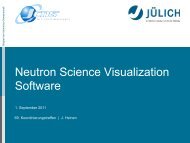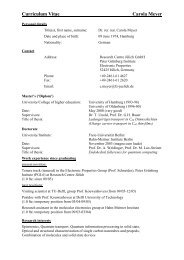Innovatives Supercomputing in Deutschland - Forschungszentrum ...
Innovatives Supercomputing in Deutschland - Forschungszentrum ...
Innovatives Supercomputing in Deutschland - Forschungszentrum ...
Create successful ePaper yourself
Turn your PDF publications into a flip-book with our unique Google optimized e-Paper software.
<strong>in</strong>SiDE • Vol. 9 No.2 • Autumn 2011<br />
<strong>Innovatives</strong> <strong>Supercomput<strong>in</strong>g</strong><br />
<strong>in</strong> <strong>Deutschland</strong>
Applications<br />
Figure 1:<br />
Phase diagram of PC<br />
materials and crystallization<br />
patterns.<br />
(a) The most commonly<br />
used materials<br />
for optical record<strong>in</strong>g<br />
are <strong>in</strong> Groups 1 and 2,<br />
(b) Nucleationdom<strong>in</strong>ated<br />
growth<br />
recrystallization<br />
(as <strong>in</strong> GST),<br />
(c) Growth-dom<strong>in</strong>ated<br />
recrystallization<br />
(as <strong>in</strong> AIST).<br />
JUGENE unravels Structures<br />
<strong>in</strong> Phase Change Materials<br />
Phase change (PC) materials rema<strong>in</strong><br />
lead<strong>in</strong>g candidates for future computer<br />
Random Access Memory (RAM) and<br />
rewritable storage devices (CD-RW,<br />
DVD-RW, DVD-RAM, and<br />
Blu-ray Disc, BD). The<br />
battle to replace the de facto<br />
standard of optical record<strong>in</strong>g<br />
materials, the Digital<br />
Versatile Disk (DVD),<br />
was decided <strong>in</strong> 2008<br />
<strong>in</strong> favour of Blu-ray<br />
Disc, and the record<strong>in</strong>g<br />
media<br />
of all BD<br />
products<br />
<strong>in</strong>volve PC materials. Many readers will<br />
know that laser light is <strong>in</strong>volved, but not<br />
all know how the <strong>in</strong>formation is recorded,<br />
read, and erased.<br />
Information is stored<br />
<strong>in</strong> these devices <strong>in</strong> the<br />
form of microscopic bits<br />
(each less than 100 nanometers<br />
<strong>in</strong> size) <strong>in</strong> a th<strong>in</strong><br />
layer of a polycrystall<strong>in</strong>e<br />
alloy conta<strong>in</strong><strong>in</strong>g<br />
several elements.<br />
The bits can have<br />
a disordered<br />
(amorphous) or<br />
an ordered<br />
(crystall<strong>in</strong>e)<br />
structure.<br />
The transition between the two phases<br />
is not only extremely rapid (some tens<br />
of nanoseconds), but it is reversible.<br />
Amorphous bits are formed by quench<strong>in</strong>g<br />
after a localized and short (~ 1 ns)<br />
pulse to above the melt<strong>in</strong>g temperature.<br />
Longer laser heat<strong>in</strong>g (of the order of<br />
10 ns) to above the glass transition but<br />
below the melt<strong>in</strong>g po<strong>in</strong>t returns the bit<br />
to a metastable crystall<strong>in</strong>e form. The<br />
state can be identified by monitor<strong>in</strong>g the<br />
optical or electrical properties.<br />
The physical requirements of PC materials,<br />
particularly the rapid crystallization,<br />
are satisfied by relatively few materials.<br />
The focus for some years now has been<br />
on alloys of three or four elements,<br />
many of which conta<strong>in</strong> germanium (Ge),<br />
antimony (Sb) and tellurium (Te), and<br />
are referred to as “GST alloys” (Fig. 1a).<br />
Alloys along the l<strong>in</strong>e connect<strong>in</strong>g GeTe<br />
and Sb Te (Group 1) are common PC<br />
2 3<br />
materials, particularly Ge Sb Te , which<br />
2 2 5<br />
is used <strong>in</strong> DVD-RAM, and alloys near<br />
the GeTe end, which are favoured <strong>in</strong> BD<br />
applications. Also shown <strong>in</strong> Figure 1<br />
are alloys near Sb (70%) and Te (30%)<br />
(Group 2). With small amounts of silver<br />
(Ag) and <strong>in</strong>dium (In), “AIST” alloys are<br />
<strong>in</strong> widespread use <strong>in</strong> DVD-RW devices.<br />
Although both alloy families conta<strong>in</strong> antimony<br />
and tellurium and appear to have<br />
much <strong>in</strong> common, the phase change<br />
mechanisms are very different. In GST<br />
materials, the amorphous bit crystallizes<br />
via nucleation, i.e. small crystallites<br />
formed <strong>in</strong> the <strong>in</strong>terior grow rapidly until<br />
they cover the whole bit (Fig. 1b). The<br />
phase change <strong>in</strong> AIST alloys proceeds from<br />
the outside of the bit, where it adjo<strong>in</strong>s<br />
the crystall<strong>in</strong>e surround<strong>in</strong>gs, towards its<br />
<strong>in</strong>terior (Fig. 1c).<br />
Materials <strong>in</strong> both groups have superior<br />
rewrite speeds and are stable at room<br />
temperature for long periods, <strong>in</strong>dispensable<br />
characteristics of PC memories.<br />
Figure 2: The simulation of 460 atoms and 52 vacancies <strong>in</strong> (a) crystall<strong>in</strong>e GST and (b) amorphous GST. Red: Ge, blue: Sb, yellow: Te.<br />
Cavities are shown as light blue isosurfaces. A s<strong>in</strong>gle large cavity is one of numerous cavities <strong>in</strong> a-GST.<br />
12 Autumn 2011 • Vol. 9 No. 2 • <strong>in</strong>SiDE Autumn 2011 • Vol. 9 No. 2 • <strong>in</strong>SiDE<br />
13<br />
Applications
Applications<br />
Until recently, however, there was little<br />
understand<strong>in</strong>g of the crucial - and ratelimit<strong>in</strong>g<br />
- crystallization process and no<br />
conv<strong>in</strong>c<strong>in</strong>g explanation for its astonish<strong>in</strong>g<br />
rapidity. The comb<strong>in</strong>ation of extensive<br />
simulations on the Jülich supercomputer<br />
JUGENE with new experimental data<br />
and x-ray spectra from the Japanese<br />
synchrotron SPr<strong>in</strong>g-8, the world’s most<br />
powerful x-ray source, has enabled<br />
the structures of the amorphous<br />
phases of both Ge Sb Te 2 2 5<br />
and<br />
an AIST alloy<br />
to be determ<strong>in</strong>ed.<br />
It has been possible <strong>in</strong> both cases to<br />
develop models that expla<strong>in</strong> the rapid<br />
phase change.<br />
The calculations <strong>in</strong>volved density functional<br />
simulations of the cool<strong>in</strong>g process from<br />
a high-temperature liquid down to room<br />
temperature, and the number of atoms<br />
<strong>in</strong> the unit cell (460 <strong>in</strong> GST, 640 <strong>in</strong> AIST)<br />
and the total simulation times (hundreds<br />
of picoseconds <strong>in</strong> both cases) make<br />
them by far the most extensive<br />
“Car-Parr<strong>in</strong>ello” [1] studies of such<br />
materials. In the case of<br />
Ge Sb Te , we show <strong>in</strong> Fig. 2<br />
2 2 5<br />
the ordered<br />
(a) and amorphous<br />
(b) structures. Although<br />
the latter looks very<br />
messy on first sight,<br />
closer <strong>in</strong>spection shows<br />
that both the amor-<br />
Figure 3: Model of crystallization of an AIST alloy. Upper left: a laser pulse (hv arrow) causes motion of the central antimony atom (left),<br />
which then exchanges its bonds to two neighbours. Upper right: The green vector sum of the three short red bonds changes.<br />
Below: A sequence of such processes leads from the amorphous (left) to the crystall<strong>in</strong>e form (right).<br />
phous and crystall<strong>in</strong>e phases conta<strong>in</strong> the<br />
same structural units, “ABAB” r<strong>in</strong>gs.<br />
These four-membered r<strong>in</strong>gs conta<strong>in</strong> two<br />
germanium or antimony atoms (A) and<br />
two tellurium atoms (B) and can rearrange<br />
<strong>in</strong> the available empty space without<br />
break<strong>in</strong>g many atomic bonds. This observation<br />
is consistent with the very<br />
rapid crystallization of the amorphous<br />
phase, but the details of the<br />
process rema<strong>in</strong> to be<br />
clarified.<br />
In the case of AIST, it was<br />
possible to determ<strong>in</strong>e a<br />
structure of the amorphous phase that<br />
reproduced the x-ray scatter<strong>in</strong>g data of<br />
our Japanese colleagues [3].<br />
In conjunction with the known structure<br />
of the crystall<strong>in</strong>e phase, this has aga<strong>in</strong><br />
allowed us to propose a model for the<br />
crystallization process (Fig. 3). In this<br />
“bond exchange model”, the local environment<br />
<strong>in</strong> the amorphous bit is changed<br />
by small movements of an antimony<br />
atom (see Fig. 3, above) that result <strong>in</strong> the<br />
exchange of a short and a long bond.<br />
A sequence or avalanche of many such<br />
steps results <strong>in</strong> reorientation<br />
(crystallization), without requir<strong>in</strong>g large<br />
atomic motions or the empty regions<br />
that were present <strong>in</strong> GST, but are absent<br />
here. The antimony atoms, stimulated<br />
by the laser pulse, have simply exchanged<br />
the strengths of the bonds to two<br />
neighbours.<br />
The deeper theoretical understand<strong>in</strong>g<br />
of the processes <strong>in</strong>volved <strong>in</strong> writ<strong>in</strong>g and<br />
eras<strong>in</strong>g memory devices should aid the<br />
development of phase change storage<br />
media with longer life, larger capacity,<br />
and/or shorter access times. Naturally<br />
it would be highly desirable to simulate<br />
the actual crystallization process and<br />
see whether these models<br />
are more than just plausible<br />
explanations. The time<br />
scale <strong>in</strong>volved makes<br />
such calculations extremely<br />
challeng<strong>in</strong>g, but we are perform<strong>in</strong>g<br />
them for GST at the moment and<br />
are very optimistic about the prospects.<br />
References<br />
[1] Car, R., Parr<strong>in</strong>ello, M.<br />
Unified approach for molecular dynamics<br />
and density functional theory, Phys. Rev.<br />
Lett. 55, 2471 (1985)<br />
[2] Akola, J., Jones, R. O., Kohara, S.,<br />
Kimura, S., Kobayashi, K., Takata, M.,<br />
Matsunaga, T., Kojima, R., Yamada, N.<br />
Experimentally constra<strong>in</strong>ed densityfunctional<br />
calculations of the amorphous<br />
structure of the prototypical phase-change<br />
material Ge Sb Te , Phys. Rev. B 80,<br />
2 2 5<br />
020201(R) (2009)<br />
[3] Matsunaga, T., Akola, J., Kohara, S.,<br />
Honma, T., Kobayashi, K., Ikenaga, E.,<br />
Jones, R. O., Yamada, N., Takata, M.,<br />
Kojima, R.<br />
From local structure to nanosecond<br />
recrystallization dynamics <strong>in</strong> AgInSbTe<br />
phase change materials, Nature Materials<br />
10, 129 (2011)<br />
• Jaakko Akola 1<br />
• Robert O. Jones 2<br />
14 Autumn 2011 • Vol. 9 No. 2 • <strong>in</strong>SiDE Autumn 2011 • Vol. 9 No. 2 • <strong>in</strong>SiDE<br />
15<br />
1 Tampere<br />
University of<br />
Technology,<br />
F<strong>in</strong>land<br />
Applications<br />
2 <strong>Forschungszentrum</strong><br />
Jülich, PGI-1, Jülich







